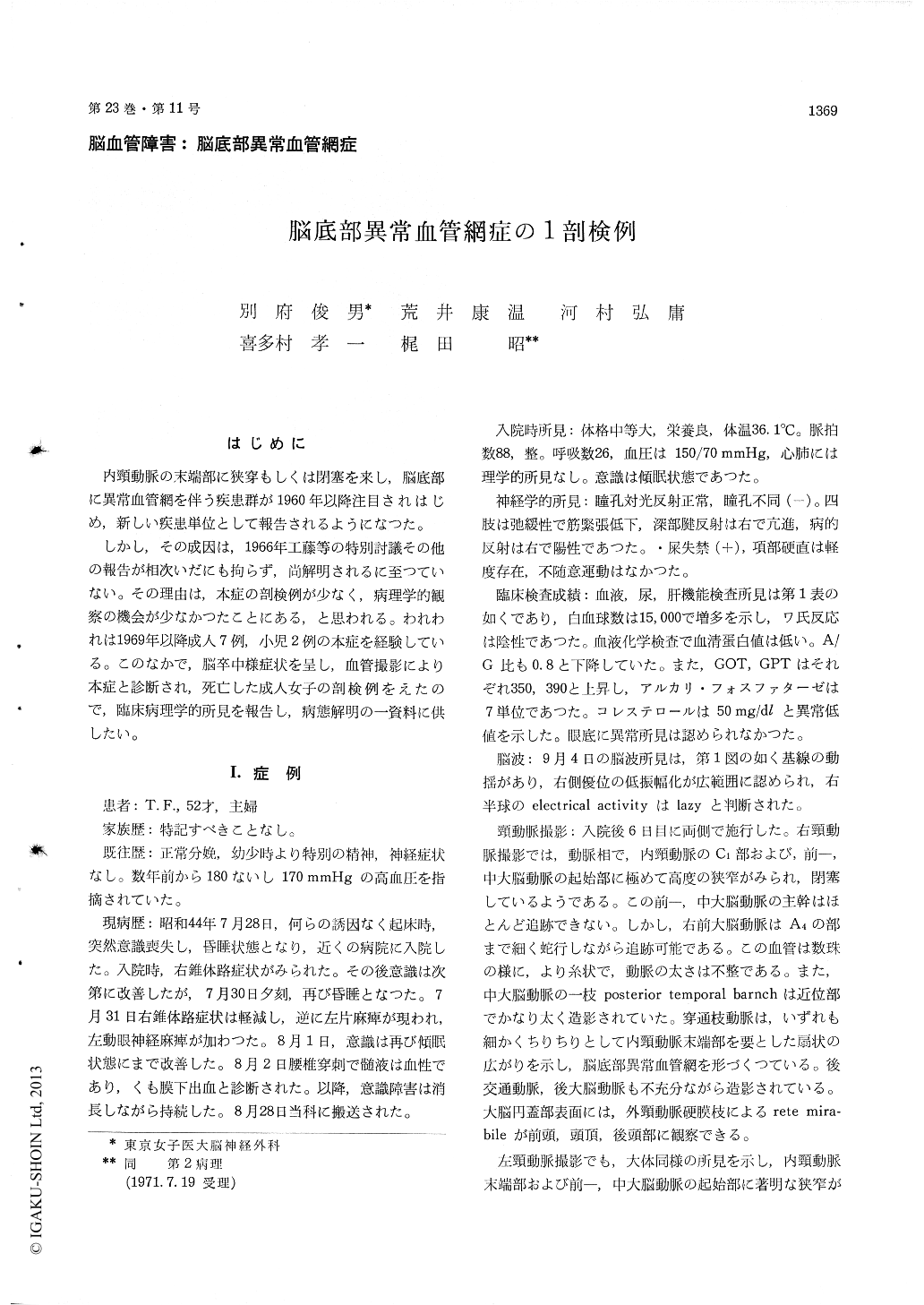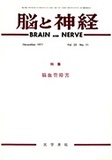Japanese
English
- 有料閲覧
- Abstract 文献概要
- 1ページ目 Look Inside
はじめに
内頸動脈の末端部に狭穿もしくは閉塞を来し,脳底部に異常血管網を伴う疾患群が1960年以降注目されはじめ,新しい疾患単位として報告されるようになつた。
しかし,その成因は,1966年工藤等の特別討議その他の報告が相次いだにも拘らず,尚解明されるに至つていない。その理由は,本症の剖検例が少なく,病理学的観察の機会が少なかつたことにある,と思われる。われわれは1969年以降成人7例,小児2例の本症を経験している。このなかで,脳卒中様症状を呈し,血管撮影により本症と診断され,死亡した成人女子の剖検例をえたので,臨床病理学的所見を報告し,病態解明の一資料に供したい。
The cerebral juxta-basal telangiectasia has been defined as remarkable stenosis or occlusion of main arteries in the anterior portion of Willis' circle as-sociated with vascular network composed mainly of arteries and arterioles in the cerebral base. As for its etiology, however, many hypotheses have been recently discussed.
A 52-year-old female suffered from apoplectic ttack with sudden loss of consciousness and was followed by the remittent unconscious state and pyramidal sign on the right side. Spinal tap dis-closed bloody cerebrospinal fluid at another hospi-tal. The patient was hospitalized at our hospital on Aug. 28, 1969 with above complaints.
On admission, bilateral carotid angiograms rev-ealed stenosis or obstruction of the distal portion of the internal carotid arteries (just above the ori-gin of the ophthalmic artery). The proximal por-tion (A1 & M1) of the anterior and middle cerebral arteries were not well visualized bilateraly. The right anterior cerebral artery (A2-A4), however, as a tortuous narrowing vessel and the posterior temporal branches of the right middle cerebral art-ery were recongnized distinctly.
The vascular network was characterized by thefork and reticular picture in the vicinity of the carotid occlusion, mainly composed of the numerous perforators rising from posterior communicating artery and anterior choroidal artery. Another source of collateral supply seemed to be the many anastomoses by the rete mirabile, meningeal, oph-thalmic, occipitale and posterior choroidal arteries respectively. On the other hand, each angiogram on the peripheral arterial, venous and sinous phase showed no abnormal vascularity.
The patient gradually deteriorated. Any con-servative therapy did not result in favorable re-sponse and progressed to his termination, 39 days after the onset of her illness.
Gross autopsy findings :
1) A coagular mass which had been unable to discover its bleeding origin, was found bulkily in the right ventricle and which invaded into the internal capsule and corpus callosum, and also as-sociated with gross softening in the cortical area supplied from the anterior and middle cerebral arteries.
2) The intracranial portion of the internal car-otid artery (C1) was found to be markedly narrowed and hypoplastic to distal sites of the ophthalmic arterial branch.
3) The anterior half of Willis' circle was also hypoplastic and obstructed with partial stenosis.
Histological examination ;
1) Intimal proliferation characterized by the intimal pads, so called polster, was especially evidentat the main arteries of the anterior half of Willis' circle. The intimal elastic lamina was well pre-served, but was of marked elongation and undula-tion and undulation with thinning of media.
2) The vascular network consisted of many per-forators to the basal ganglia. Some of these branches of the perforators in the diencephalon developed stenosis or dilation associated with ab-normal undulation of elastic lamina without its intimal thickening.
3) The anastomoses of perforators were recog-nised as the satellate formation in the subarachnoi-dal space and the cortical layer, but was not noticed in the intracerebral tissues.
While the authors, therefore, considered these histological and clinical findings may have contri-buted a lot to support toward bringing the hypo-thesis of congenital genesis on the base of the his-tological architecture of obstructed arteries, it seemed to be assumable that arterial obstruction started gradually at least in young adulthood because of larger surrounding length of internal elastic lamina compared with that of in infant period and childhood.
Then, so far as our histological examination of this case, the authors can't help supporting both hypotheses of congenital and aquired genesis. The authors have briefly discussed the genetic cause of the disease considering the histological findings, and reviewed reports of comparable cases.

Copyright © 1971, Igaku-Shoin Ltd. All rights reserved.


